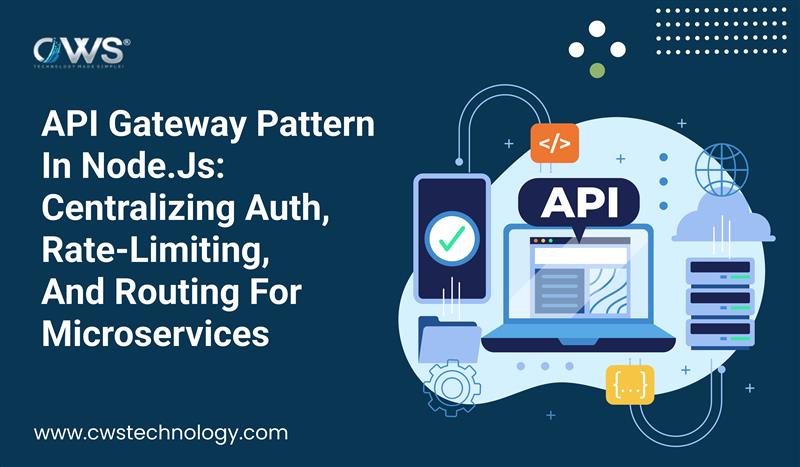API Gateway Pattern in Node.js has become a cornerstone in modern microservices architecture. As businesses scale globally, they increasingly rely on microservices to achieve agility, scalability, and independent deployments. But microservices bring along their own challenges—managing authentication across distributed services, enforcing rate limits for performance, and routing client requests seamlessly. This is where the API Gateway Pattern in Node.js steps in, acting as the central entry point to streamline communication and ensure robust security.
In this blog, we’ll explore what the API Gateway Pattern is, why it is crucial for microservices, how Node.js makes it effective, and what best practices businesses worldwide can adopt to stay competitive.
What is the API Gateway Pattern in Node.js?
The API Gateway Pattern is a design pattern where all client requests pass through a single gateway before reaching backend microservices. Instead of exposing dozens of endpoints directly to clients, organizations introduce a centralized gateway that manages requests, applies cross-cutting concerns (like authentication and rate-limiting), and routes them to the correct service.
When implemented with Node.js, this gateway becomes fast, lightweight, and scalable. Node.js is particularly well-suited for building API Gateways because of its non-blocking I/O, high concurrency handling, and ability to integrate with modern cloud environments.
Why Do We Need an API Gateway in Node.js for Microservices?
Microservices deliver flexibility and innovation, but they complicate system design. Here’s why companies worldwide use an API Gateway in Node.js:
- Centralized Authentication:
Without a gateway, each service would need to handle its own authentication logic. This duplication increases security risks and makes maintenance difficult. With an API Gateway, you authenticate once at the gateway level, ensuring a consistent and secure process across all microservices. - Rate-Limiting and Throttling:
High-traffic spikes can overwhelm backend services. By implementing rate-limiting at the gateway, you prevent abuse, ensure fair usage, and protect services from downtime. - Routing and Request Transformation:
Instead of clients remembering dozens of microservice endpoints, the gateway simplifies interactions by providing a unified entry point. It can also transform requests, aggregate responses, and adapt to different client needs. - Observability and Monitoring:
The API Gateway provides a central place to log, monitor, and analyze requests, making it easier to detect anomalies and track performance. - Global Scalability:
As organizations scale internationally, having a single point of control ensures that policies, security, and compliance remain consistent across regions.
Key Features of API Gateway Pattern in Node.js
When building an API Gateway in Node.js, developers typically implement:
- Authentication & Authorization: Integrating with OAuth, JWT, or SSO providers.
- Rate-Limiting: Using tools like Redis or in-memory solutions to throttle requests.
- Request Validation: Ensuring payloads are valid before reaching backend services.
- Routing: Mapping incoming requests to the correct microservice.
- Response Aggregation: Combining data from multiple services into a single response.
- Caching: Reducing latency by storing frequently accessed data.
- Monitoring & Logging: Using tools like ELK stack or Prometheus for visibility.
Building an API Gateway in Node.js
A typical implementation looks like this:
- Set Up Express.js: Node.js developers often use Express.js as the foundation for handling HTTP requests.
- Add Middleware for Authentication: A JWT verification middleware can secure endpoints.
- Implement Rate-Limiting: Libraries like express-rate-limit or Redis-backed solutions help enforce limits.
- Configure Routes: Use reverse proxy techniques with libraries like http-proxy-middleware to forward requests.
- Add Monitoring Tools: Log requests and responses centrally for auditing and debugging.
For global businesses, Node.js gateways can be deployed in Kubernetes clusters or serverless environments, making them flexible and cloud-native.
Advantages of the API Gateway Pattern in Node.js
- Simplified Client Experience: Clients only interact with one endpoint.
- Improved Security: One centralized place for authentication and SSL termination.
- Operational Efficiency: Cross-cutting concerns are implemented once, not duplicated.
- Scalability: Node.js handles thousands of concurrent requests efficiently.
- Future-Ready Architecture: Easy to extend with plugins, middleware, or third-party integrations.
Global Use Cases of API Gateway Pattern in Node.js
- E-commerce Platforms: Handling millions of requests during seasonal sales, while applying authentication and rate-limiting at scale.
- FinTech Applications: Securing payment services and ensuring compliance with regulations by enforcing centralized policies.
- Healthcare Solutions: Protecting sensitive data through unified authentication layers.
- SaaS Startups: Offering unified APIs to customers while managing backend complexity.
Best Practices for Implementing API Gateway Pattern in Node.js
- Use JWT for Scalable Authentication: It avoids state management issues.
- Enable Caching at the Gateway: Improves performance for high-traffic endpoints.
- Integrate Circuit Breakers: Protect microservices from cascading failures.
- Leverage Cloud-Native Tools: Deploy Node.js gateways in environments like AWS API Gateway or Kubernetes ingress controllers.
- Regularly Monitor and Audit: Ensure logs and metrics are actively monitored to detect anomalies early.
Conclusion
The API Gateway Pattern in Node.js is no longer optional—it’s a necessity for organisations running micro services at scale. By centralising authentication, applying rate-limiting, and routing client requests efficiently, businesses can improve security, performance, and customer experience. Whether you’re a startup scaling rapidly or a global enterprise managing complex systems, adopting this pattern in Node.js ensures your architecture remains robust, future-proof, and competitive.
At CWS, we believe in building smart, scalable, and secure digital solutions that leverage modern patterns like API Gateway in Node.js to help businesses thrive globally.








